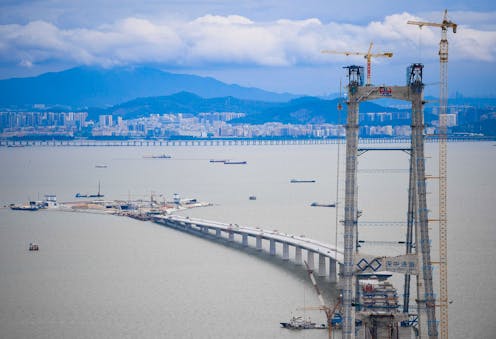How do you build tunnels and bridges underwater? A geotechnical engineer explains the construction tricks
- Written by Ari Perez, Associate Professor of Civil Engineering, Quinnipiac University

While modern machinery is quite advanced, this method of construction started about 200 years ago with the tunneling shield[8]. Initially, these were temporary support structures that provided a safe space from which workers could excavate. New temporary structures were built deeper and deeper as the tunnel grew. As the designs improved with experience, the shields were built to be mobile and eventually evolved into the modern tunnel-boring machine.
Building on dry land before moving into place
Some structures will ultimately be surrounded by water, resting on a riverbed or ocean floor. Luckily, engineers have some tricks up their sleeves to build bridges and tunnels that have components in direct contact with the water.
Underground construction is dangerous and hard to access. Dealing with water brings additional challenges. While soil and rock can be moved aside to create a stable opening, water will always move in to fill any gap and must continuously be pumped away.
Human beings, materials and machinery don’t really work well underwater, either. People need a constant air supply. Placing concrete is difficult underwater, and some materials work only on dry land. And since gas engines rely on air to operate, underwater equipment is very limited.
Some smaller tasks – aligning and joining pre-built sections of tunnel or inspecting to make sure submersion didn’t damage anything – are performed beneath the waves, but the bulk of construction is unlikely to be. Once the structure is in place, there’s constant monitoring and assessment happening underwater.
Because people generally can’t build underwater, there are two options: Do the building in the open and move it underwater, or temporarily transform the underwater site into a dry one.
Engineers have a few techniques for constructing underwater tunnels.For the first option, crews typically build parts of the structure on dry land and then sink them into place. For instance, the Ted Williams Tunnel[9] in Boston was constructed in sections in a shipyard. Workers dredged the tunnel’s future path in Boston Harbor, cleaning mud and other refuse out of the way. Then they placed the sealed segments along the prepared trench. Once the segments were connected, they opened the ends of the segments to create one long, continuous tube. Finally, the tunnel was covered with soil and rock. Very little of the construction process was actually done underwater.
In other cases, such as in shallow water, construction workers may be able to build directly from the surface. For instance, workers can drive waterfront retaining walls made out of sheet metal into the soil directly from a barge, without having to divert the water.
Temporarily clearing the water away
The second option is to get rid of the underwater problem entirely.
While creating a dry site at the bottom of a body of water is difficult, it does have a long history. After leading the sack of Rome in 410 C.E., Visigoth king Alaric died on his way home. In order to protect his magnificent burial from grave robbers, Alaric’s people temporarily diverted a local river[10] to bury him and his loot in the riverbed before letting the river rush back over.
Nowadays, a project like this would use a cofferdam[13]: a temporary, watertight enclosure that can be pumped dry to provide an open and safe site for construction. Once the area is enclosed and pumped free of water, you’re in the realm of regular construction.
Using a caisson is another way to provide a dry area at a site that is typically underwater. A caisson is typically a prefabricated and water-tight structure, shaped like an upside-down cup, that a crew sinks into the water. They keep it pressurized to ensure that water will not rush in. Once the caisson is on the floor of the body of water, the air pressure and pumping keep the site dry and allow construction workers to build inside. The caisson becomes part of the finished structure.
Builders constructed the piers of the Brooklyn Bridge[15] using caissons. Although the caissons were structurally safe, the difference in pressure affected many workers, including the chief engineer, Washington Roebling. He developed caisson disease – more commonly known as decompression sickness[16] – and had to resign.
Underwater construction is a complex and difficult task, but engineers have developed several ways to build underwater … often by not building underwater at all.
Hello, curious kids! Do you have a question you’d like an expert to answer? Ask an adult to send your question to CuriousKidsUS@theconversation.com[17]. Please tell us your name, age and the city where you live.
And since curiosity has no age limit – adults, let us know what you’re wondering, too. We won’t be able to answer every question, but we will do our best.
References
- ^ Curious Kids (theconversation.com)
- ^ curiouskidsus@theconversation.com (theconversation.com)
- ^ a Calvin and Hobbes comic strip (www.gocomics.com)
- ^ I’m a geotechnical engineer (scholar.google.com)
- ^ tunnel-boring machines (www.asme.org)
- ^ build the Chunnel (edtech.engineering.utoronto.ca)
- ^ University Archives and Special Collections at UMass Boston (openarchives.umb.edu)
- ^ tunneling shield (www.britannica.com)
- ^ Ted Williams Tunnel (clui.org)
- ^ temporarily diverted a local river (italiantribune.com)
- ^ U.S. Army Corps of Engineers Digital Visual Library (en.m.wikipedia.org)
- ^ CC BY (creativecommons.org)
- ^ cofferdam (www.britannica.com)
- ^ Fotosearch/Getty Images (www.gettyimages.com)
- ^ constructed the piers of the Brooklyn Bridge (fromthepublicdomain.com)
- ^ more commonly known as decompression sickness (doi.org)
- ^ CuriousKidsUS@theconversation.com (theconversation.com)
Authors: Ari Perez, Associate Professor of Civil Engineering, Quinnipiac University

